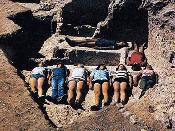|
|
|
 |
|
"
'MARY!' JESUS SAID.
TURNING AROUND,
SHE SAID TO HIM IN HEBREW, 'RABBONI'
WHICH MEANS 'TEACHER' " JOHN
20:16
|
|

|
 |
Hebrew
was the language of the ancient Israelites.
David courted Bathsheba in Hebrew and when they were
married, he may have greeted her every morning with
boker tov (good morning). David might
have said mazal tov (congratulations) to
Solomon his son at his coronation by the Gihon
spring. The prophet Isaiah, a Jerusalem
native, preached in Hebrew.
The Judeans went off to Babylon weeping in Hebrew,
but when they returned, they brought with them their
new mother tongue, Aramaic. And by the time of
Jesus, Aramaic had completely replaced Hebrew as the
spoken language of daily life. There’s no
doubt that Jesus knew Hebrew, but he most probably
preached in Aramaic.
“Hebrew” is mentioned a number of times in the New
Testament. John, in chapter 5 says, “By the
Sheep Gate in Jerusalem there is a pool, called
Bethesda in Hebrew which has five colonnades.”
Bethesda is a combination of two Hebrew words:
beit which means “home of” and hesed
which means "grace." The Pool of Bethesda,
right outside the northern gate leading into the
Temple courtyard, was a place of healing. It was
said that the first person to jump into the waters
when they stirred would be healed of his affliction.
This is where Jesus told the man who was lame for 38
years, “Pick up your mat and walk.” (John 5:8)
In the Garden of Gethsemane (meaning “oil press” in
Hebrew and Aramaic), Jesus used the Hebrew and
Aramaic word for father, Abba. Abba is
a diminutive indicating closeness, like saying
“daddy,” rather than the more formal Av which
means father. “And he said, Abba, Father, all
things are possible for You; take this cup away from
Me: nevertheless not what I will, but what You
will.” (Mark 14:36)
When Jesus was taken out to be crucified, John’s
Gospel mentions that the sign Pontius Pilate ordered
be put on the cross was written in Hebrew, along
with Latin and Greek. “Many of the Jews read
this sign, because the place where Jesus was
crucified was near the city; and it was written in
Hebrew, Latin and Greek.” (John 19:20) This is
the meaning of the Hebrew letters that appear in
many crucifixion paintings.
During a chaotic incident when Paul was arrested in
the Temple courtyard, the Book of Acts states
specifically that Paul addressed the unruly crowd in
Hebrew. “When they heard that he was
addressing them in the Hebrew language, they became
even quieter.” (Acts 22:2) |
| |
|
 |
|
Photo: Gila
Yudkin |
|
Model of the Second Temple in the
days of Jesus |
| |
| But when
the Second Temple was destroyed by the Romans and
the Jews went off to exile once again, spoken Hebrew
just died out. It was much like Latin became later –
no one spoke it as his mother tongue. It was
studied, read, written and recited in prayer, but
not used as a means of verbal communication.
Religious Jews even considered it blasphemous to use
the “holy tongue” within the context of daily life. |
| |
| Indeed,
Hebrew would not be the common spoken language of
the people of Israel until the end of the nineteenth
century, when a Jewish immigrant from Lithuania
named Eliezer Ben Yehuda had the far-fetched idea of
reviving it. As he stepped off the boat onto
the Land of Israel, he informed his wife, “From now
on, we speak only Hebrew.” Her words were not
recorded. Ben Yehuda soon discovered to his dismay,
that a major obstacle in “modernizing” Hebrew was in
the area of vocabulary. |
| |
|
|
Biblical Hebrew had a remarkably small
number of words – 8,000 at most, with 1,700
used only once as compared to modern English
which has over 450,000. As a basis of
comparison, French, Spanish and Arabic each
have about 175,000 words. Today Modern
Hebrew, which uses virtually the same
alphabet as the Jews of 2,000 years ago, has
about 100,000 words.
You know a few: Hallelujah is “praise the
Lord.” Shalom is peace.
Would you like to learn some handy Hebrew
phrases and contemporary slang which will help you connect
and joke with
people you’ll be meeting on your journey in
the Holy Land? See
Hebrew for Pilgrims. |
|
|
Walk the Temple Mount with Abraham and
Isaac, David and Solomon, Jesus and the
disciples, Mohammed and the angel Gabriel
with
Gila's
Temple Mount audio tour on MP3 or
CD.
Gila's Temple Mount tour
is now also available as a written
24-page PDF with a
Temple Mount plan,
guidelines for passing the security check
and ten recommended reads on the
Temple Mount from Gila's bookshelves.
|
|
More on Hebrew Inscriptions |
| |
 |
 |
 |
|
Siloam inscription
|
Discovery of
the Dead
Sea Scrolls |
Priestly Benediction
|
|
|
|
GILA
YUDKIN
•
TCHERNIKOVSKI
64A
•
JERUSALEM
•
ISRAEL
EMAIL: gila@itsgila.com
HOME
•
HOLY
LAND
HEROINES
•
SONGS
& PRAISE •
ABOUT GILA
|
|

